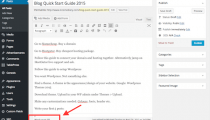
How To Create Profitable Content – And Build A Huge Audience
A profitable content marketing strategy is the best thing you can do to grow your blogging business.
Yet, so many bloggers fail to create content with profit in mind. They produce useful information but don’t make any money.
This is about fixing that!
How To Create Profitable Content
A whopping 96% of content marketers have stated that content has helped them to develop a credible and trustworthy brand.
That is not a coincidental figure. Content provides a platform for businesses to stand on and makes building brand awareness easier.
However, the truth is that not all content was created equally.
According to Ahrefs, 90.63% of content gets no traffic from Google. Statistically, if you create 100 articles, you can expect only 10 of them to ever receive traffic from organic search.
However, the good news is that this doesn’t have to be the case. We will show you many techniques to improve your chances of ranking well and getting traffic.
We will walk you through how to ethically create profitable content without compromising your business’s values.
What Makes Profitable Content
The phrase “content is king” is pretty overused, but there is a level of truth to it. Content is a fantastic way to get ahead when building a high-yielding marketing strategy.
Organic content can make money in several ways. Firstly, from advertising, companies like Ezoic and Mediavine will pay bloggers a set fee for the number of page views they receive every month.
Typically, this isn’t a lot. Between $5-$20 per 1,000 views can be expected. Most articles are lucky to get 1,000 views a month, so this is unlikely to ever be truly profitable.
This means that content-driven businesses need a different (and better) model for monetization.
Keyword research is the foundation for identifying profitable content ideas. Through proper keyword research, you can identify profitable topics to write about. When looking for profitable keywords to write about, you should look for “buyer intent” trigger keywords. These include “best”, “vs”, and “review”.
Some examples include:
- Best handbags under $1000
- Ahrefs vs SEMrush
- Quickbooks Review
As you can see, these keywords can relate to any niche. Creating content around profitable transactional keywords like these allows you to position your content in a place where you can drive purchase decisions.
As a result, you will be able to directly impact the customer journey, and brands will be willing to pay good money for this, whether that is through affiliate commissions or direct sponsorships.
Don’t Compromise On Integrity
Although creating content that has the opportunity to be profitable is essential, so is building an audience. If you want to build an audience, your content must provide genuine value for readers.
Hyper-focusing on the profitability of your content will be immediately apparent to readers, and it will show that you are more bothered about making money than creating excellent content.
Striking a balance between creating helpful content and content that can make you a lot of money is crucial, so how can you do this?
Well, first, you should create an editorial calendar. You can add blog post ideas to this calendar as you perform keyword research. To achieve this balance, you should aim to write about half your posts on high-intent commercial-focused keywords and the other half on purely informational posts.
You can quickly identify keywords based on search intent by utilizing good SEO tools (some are free).
Informational posts include “how-to guides” and “statistics” posts. It would be a huge mistake to assume that this type of content can’t make you any money. In fact, informational content will become the foundation of your brand.
We will get on to the technical details later, but for now, remember that informational content attracts a broader audience, shares, and authoritative backlinks.
Creating profitable content isn’t easy, and you need to keep a few key components in mind – most notably, SEO (search engine optimization).
On-Page SEO-Components
There are two critical parts to SEO; the on-page and off-page components. Firstly, we will discuss on-page SEO and provide some actionable strategies you can use to create profitable content.
Keywords are the bread and butter of on-page SEO. Each article you write should be optimized to rank in organic search for a specific keyword.
Keywords can be short or long tail.
A short-tail keyword will typically be just one or two words:
For example, “credit cards”
Whereas a longer-tail keyword is longer and much more specific:
Example: “how to apply for a credit card”.
While short-tail keywords may be tempering (due to their high search volume), it’s far better to write content centered around long-tail keywords because they are much more focused and easier to rank for.
Once you have conducted your keyword research and selected a long-tail keyword, there are a few things you can do to quickly optimize your article:
- Use the keyword in your title
- Use the keyword in your headings
- Include lots of semantic variations of the keyword
- Include internal links to other articles on your website
- Link out externally to a few high-quality resources
- DO NOT overuse the exact keyword. This is known as keyword-stuffing, and it’s seen as an attempt to manipulate rankings.
Off-Page SEO-Components
However, the on-page SEO components aren’t the only thing you need to consider when it comes to creating profitable content.
To rank well in organic search, you must build up your E-A-T (expertise, authoritativeness, and trust).
The best way to do this is by building backlinks to your articles and home page. However, backlinks are very easy to get wrong. So, here are a few things to avoid when building backlinks.
- Never pay for backlinks. This is manipulative, and if you get caught, Google will penalize your website severely.
- Only build high-quality backlinks. Commenting on other people’s blogs will not earn you valuable backlinks.
- Please avoid using freelance websites like Fiverr for backlinks. Most of the services offered are scams.
So, the key takeaway is that building high-quality backlinks isn’t easy. However, that is a good thing. It means that earning genuinely valuable backlinks has a high barrier to entry, and you will need to work to acquire them.
That said, there are quite a few legitimate ways to earn backlinks, some of which are well-known and others rarely discussed. Some of the best ways to earn high-quality backlinks include:
- Guest Posting
- HARO Outreach
- Infographic Creation & Distribution
- Link-bait content e.g. statistics and original research posts
- Broken Link Building
- Podcast Interviews
How Often Should You Post
When it comes down to it, SEO is primarily a numbers game. Businesses that write and publish content consistently have the most considerable advantage in terms of SEO.
While the quality of your content is a factor, the scale of your content strategy is often swept under the rug. This shouldn’t be the case, as the amount of content on your website is directly related to your results in traffic and revenue.
Not all your content will rank on the first page and attract traffic through organic search. It will regularly feel quite “hit and miss” until you have established a more authoritative website. We recommend posting at least three times a week until you have reached 100 blog posts. You can slow down your content output and focus on content promotion at this stage.
If you are unable to commit to three blog posts or more each week, then you may want to consider investing in a content writer. The rates charged by freelancers vary, but they can often be an excellent investment in your business.
Promote Your Content
The phrase is “if you build it, they will come”. However, this isn’t the case from our experience of creating content and SEO. If you want to create profitable content, then you need to be active with your content distribution.
There are a few ways in which you can expand the reach of your content.
Firstly, sharing your content on social media every time you add a new post to your website, sharing it on a few different social media platforms is an excellent way to get some initial traffic. It also signals to Google that you are serious about your content and want it to be read.
Secondly, you may consider content syndication. This is where you let publishers share your content on their websites for free in exchange for a link to your article. Large media sites use this strategy, and it’s a fantastic way to broaden your reach and show Google that your content is trustworthy.
Finally, you may want to consider paid ads. Although this is certainly not mandatory, paying for Google ads to your content will allow you to bypass the traditional algorithmic ranking process and get real people to your content almost immediately. Paying for traffic this way is not necessarily a sustainable strategy, but it is a viable option for people with great content that needs a boost.
Creating Profitable Content
Content marketing is a massive opportunity for your business, regardless of your niche. The core concept of content marketing is providing genuine value to consumers.
You will become seen as authoritative and trustworthy by positioning your brand in a position where you are helping people. As a result, you will be able to maximize the return on investment of your marketing strategy.
Content marketing is great because it is an ethical way to drive your business forward, but it is not always easy. With that said, if you use the SEO strategies and tips in this article, you will learn how to create profitable content that both readers and Google love.
Finally, it’s important to remember that SEO is constantly changing, so keeping up to date with the latest industry trends is crucial!














